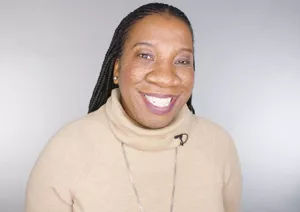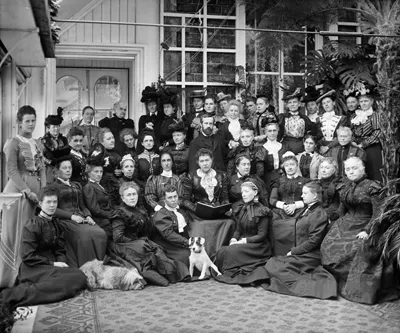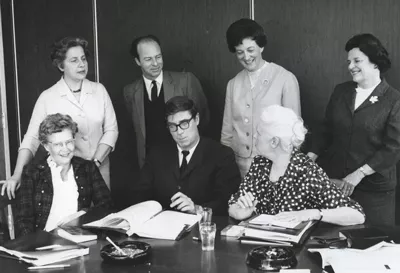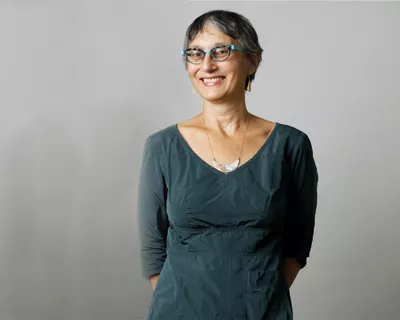
The Evolution of #MeToo
On March 8, International Women's Day, UTM is celebrating the social, economic, cultural and political achievements of women. Maeve Doyle, a UTM staff member and U of T alumna, takes this look at how society and academia have evolved for Canadian women over the decades.
While the #MeToo movement feels new, it has in fact been a millennium in the making; it is built on a foundation of significant moments in women’s quest for equality. #MeToo connects to the past through women’s practices, activism, and research and scholarship.
“In the history of women in Canada, the first big moment we look at is the thousand-year-old Iroquoian longhouse society. Women—clan mothers—chose the chiefs and women were in charge of the longhouse,” says history professor Jan Noel. Noel has taught history courses affiliated with the University of Toronto Mississauga’s Women & Gender Studies program from its beginning in 1997.

“The Commission on the Status of Women received considerable government funding for ongoing research,” says Noel. The Commission’s report published in 1970 set the agenda for about 20 years of reform. “And from that all kinds of things floated like daycare, making it easier for mothers to re-enter the workforce, making marital rape a crime and changing sexual assault laws.”
Noel calls the #MeToo moment huge. “Now, we are in this time when there is a convergence between a vast group of people who have experienced some kind of assault and a more sympathetic climate than we had even 10 years ago where those people feel that if they speak out, they will be heard.”
Professor Joan Simalchik, historian, human rights activist, Massey Senior Fellow, and Women & Gender Studies program director, says one of the biggest changes to women’s studies has been the addition of gender and the theory of intersectionality. “Race, class, indigeneity, ethnicity, ability, age and gender all play into how people experience oppression and privilege differently,” she says.

“If we look at #MeToo intersectionally, the movement was ignited more than 10 years ago by African-American social justice activist, Tarana Burke,” says Simalchik. “#MeToo has a deep history and roots and the potential for a real paradigm shift because of the work of Burke and all those other women before her; the women on the ground whose names we’ll probably never know.”
The hashtag erupted with actor Alyssa Milano’s October 15, 2017 tweet in which she invited people who have been sexually harassed or assaulted to reply with #MeToo. Simalchik says that social media has helped to spread the word, connect people and break isolation. “Sexual violence and sexual harassment are really only able to continue when they are kept secret or when people speak but aren’t listened to.” But she also says that social media is neutral. “It is how the advocates use the tool that is important. Social media is only a tool. It’s not the movement.”
When Noel pursued her doctorate in the history department at the University of Toronto in the early 80s, she says, it was a very male world in terms of what was talked about in history courses and who taught them. Similarly, as a master’s student in U of T’s History Department, Simalchik had all-male instructors and was the only woman in her cohort.
So much has changed. The history department, for example, now includes female historians and research on women in history has expanded dramatically. The Women & Gender Studies program, in response to a 43 per cent increase in student enrolment since 2010, increased its full-time faculty complement from one to six.

Daniere, the child of a culturally and racially mixed marriage, studied public policy in the late 1970s at a very conservative, white, male-dominated private university in the United States. “I was surprised by people’s limited views of diversity but once I went through, I thought, ‘I know what to expect and how I will protect myself and people and organizations that I work for’,” she says.
But obstacles still exist.
“The pools of PhD candidates are limited and constrained,” says Daniere—restricted by who makes it into university in the first place.
“The University of Toronto is working hard to continue to attract and support students who have the ability but who might not normally think of going to university,” she says.
Another obstacle is in the hiring process itself. “People have a predisposition to recognize excellence as someone who reflects themselves and their training and their education.” This implicit or unconscious bias contributes to the underrepresentation of women, faculty who are racialized or Indigenous, or faculty with disabilities. The Dean’s office will soon require that anyone involved in the search process participates in the university’s unconscious bias education to help them identify and mitigate instances of bias and to think more broadly.
Noel, Simalchik, and Daniere are—in many ways—a powerful realization of the women’s movement, and share a tremendous sense of optimism.
“The more universities rely on a diversity and multiplicity of perspectives, the more we come up with great solutions through research,” says Daniere. “I think it is our responsibility to be the leaders and show how well institutions that embrace diversity can function. Not only is it the right thing to do, but it’s good in terms of coming up with breakthrough discoveries, innovative strategies and unusually beautiful options for the future.”
